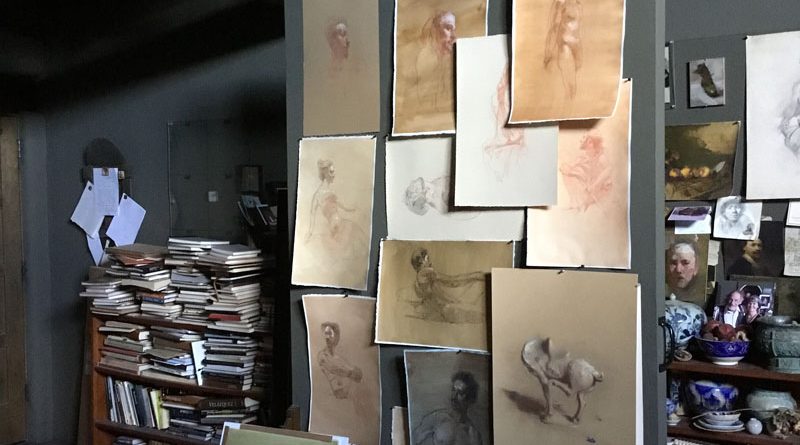Best Art Studio Color For Your Walls
Listen in and watch as Sherrie McGraw, world-renowned artist and Drawing eCourse and art instructor, as well as Jacqueline Kamin, prestigious artist & instructor, give tips on the best art studio color for your wall to feel right at home and paint with great technique!
Sherrie’s Art Studio Paint Color
BRAND: ROYAL PAINT
The formula can probably work with other brands of paint from Ace, but please confirm at the the store. Rio Grande Ace Hardware store, in Taos, NM.

Jackie:
Hi Sherrie. Good afternoon again.
Sherrie:
Good afternoon.
Jackie:
I’d like to talk to today about the best art studio color and how it affects your work for both still lives and portraits, it’s unusual.
Sherrie:
It is unusual, I think these days and a lot of artists’ studios have light walls. Like the walls behind you. But it’s actually a tradition that came from the Art Students League in New York City where both David and I taught. They had all kinds of teachers in these different studios and they had the walls painted kind of a battleship gray. And I’m sure the thinking behind it is that it absorbs a lot of the light, so that you don’t have light bouncing around and you’re able to get shadows on your subject. So, that is really the primary reason it quiets down the light. The light is more absorbed, and it doesn’t bounce all over your studio.
Best Art Studio Color
That way you can see like with the object. You know, behind me that there’s great light and shadow on it. That is due really to the walls being dark. If they were light, then I wouldn’t be able to get that dramatic a shadow. So, if it’s something that you’re interested in, in getting dramatic, light and shadow on your objects, whether it be still life or portrait then you need to have the walls, either painted dark of if you can’t do that.
I was in a studio for awhile here in Taos, the John Young-Hunter studio, and I couldn’t paint the wall star. What I did is I had a little wall. I mean, you could just do it with cardboard just around you. So, it would be like on the far side of where this still life stand is. Behind it and then coming out this way. And the important thing is to have something dark coming out this way on the shadow side, so that the light doesn’t hit something light and bounce back into it. That worked beautifully. I didn’t have to actually paint the whole room dark, you know, and it worked really well.
At home, you could even put a piece of material. But just so that, you know, the lights coming in this way, you have your set up there and then on the far side of it. So, behind it and then on the far side of it have a wall or a piece of cardboard or something coming out that’s painted darker. Then you’ll be able to get good light and shadow on your objects. I’ve had it all. I’ve had an Eastside studio too. I have had to deal with that. So not everybody has ideal situations, but this is one thing that you can do to actually create a beautiful space to paint in.
Jackie:
So, how did you come up with that color and why that color because there are a lot of dark or not dark blue or dark yellow? Does that have the same effect?
Sherrie:
Well, that’s a great question. I mean, it won’t have the same effect. The reason David and I came up with this color and you can see really behind me, just how neutral it is. The art students had gray walls, but they had this kind of cooler, battleship gray kind of gray. When we started looking through paint chips to find a good color, we just kind of gravitated to something that was more neutral. It is pretty dark and it’s very, very neutral. It is a kind of greenish gray. But it’s got a little bit of red in it. It’s really, really, really been neutralized. And, if someone really, really wanted a color swatch. I have some colors swatches. But you could also use your own taste and look at what’s behind me, and get something that is, you know, just very neutral.
You can even come up with a color you like. Paint it onto something and then bring it into your paint company and they will reproduce it. That’s what we did is basically we had it mixed. So, you come to Taos, New Mexico, you can go to the hardware store called Rio Grande and you can ask for Sherrie McGraw green. You’ll be able to get our best art studio color. But yeah, basically you can mix it. You can mix it, just something very neutral, greenish gray, you know, darker than a middle value I’d say a little bit darker.
Jackie:
In painting portraits do you find that it is a complementary color to peoples complexion.. I know that we went to Amsterdam and checked out Rembrandt’s studio it was more of a cream, not that dark of a value, but it was in the yellow family.
Sherrie:
Really, the wall color?
Jackie:
Yes.
Sherrie:
Interesting.
Jackie:
It was creamy, rich. I don’t know if that’s how it was in his day or something else. It’s hard to know exactly.
Sherrie:
I wonder, you know, what was available to them in terms of commercial paints. You know, on your wall. I don’t know but that’s interesting. I mean, the fact is, I mean, you can have any color. Mainly why we’ve chosen this is that everything against it looks good. You can just tell that the object, even though this object that I’m painting is against a rug right now. But the main thing is that it makes it so you can have shadows, it’s at a value that you can really have shadows and that’s the most important thing because you can put any color you want behind your models, behind your still life.
It could be a lighter background. It could be all kinds of things, but what’s this does, is it calms the light down so that it’s not bouncing all over the place and you can actually get form. Again, if this is something you’re interested in, but I’m assuming if you’re on our site looking that it has appeal for you. So, that’s how we get the light because it won’t just happen. You’ve got to do it on purpose.
Jackie:
Right.
Sherrie:
And the wall color is a big, big part of it. I remember early on when I was a student, even I had a friend, I had made a friend with somebody on Long Island and tried to paint in her studio. She had white walls and I just couldn’t find anything I wanted to paint. It was so difficult to paint in those circumstances. But you know, again, it has to speak to something that you want to do artistically, but if light and shadow is what you want to do, then you need to look at wall colors.
Jackie:
Now we know the color of beauty. Thank you Sherrie.
Sherrie:
Thank you Jackie.



Leave a Reply
You must be logged in to post a comment.